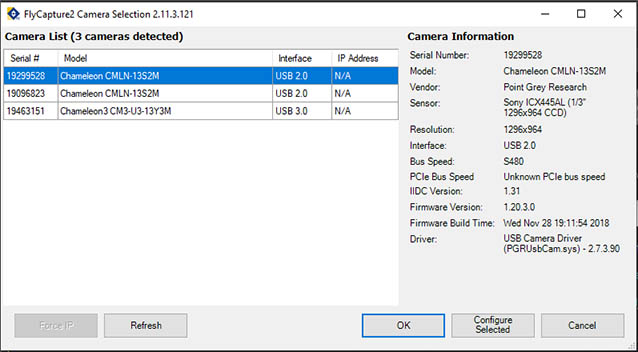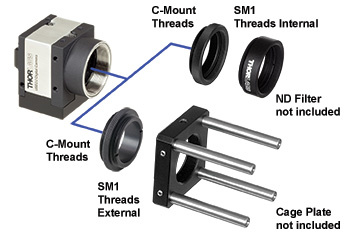- Point Grey Research Camera
- Drivers Point Grey Research Cameras Review
- Drivers Point Grey Research Cameras Wireless
CCD and CMOS cameras. From Point Grey Researchand many other manufacturers All Firewire (IEEE 1394) cameras that follow the IIDC/DCAMspecification. In the ADFireWireWin module, and support for Firewire cameras under Linux in the. FLIR was previously known as Point Grey. A key feature of the FLIR Chameleon® USB 2.0 Camera is the field-programmable gate array (FPGA) chip that controls all camera functionality, including gain, exposure, gamma, resolution and frame rate, user memory channels, and more.
- The Chameleon™ USB 2.0 digital video camera from Point Grey Research is a complete, cost effective and reliable imaging solution. A high sensitivity Sony EXview HAD CCD® sensor, combined with a hi-speed USB 2.0 digital interface, makes the Chameleon an ideal choice for demanding imaging applications such as object and gesture.
- Cameras owned by the Original Purchaser, including but not limited to, FireflyTM or DragonflyTM Camera Modules. Point Grey support uses the Point Grey Fly Capture Driver, enabling all supported functionality for Point Grey cameras. Note, This module is for Python2.
If using GigE with the USB adapter: make sure you install the driver for the adapter. EITHER the adapter will come with a CD or internet link where you can install the driver OR when you connect the adapter, the computer will automatically find the driver and load it. After the driver is installed, continue with the following directions.
1. Make sure you have Vision Acquisition Software on the computer. Check this by searching NI License Manager and checking that Vision Acquisition is ‘Activated’ (Figure 1). If it doesn’t show up in the tree to the left, it needs to be installed. If the software is not listed as ‘Activated’, select ‘Activate’ in the upper left corner and follow the directions. If it prompts you for a NI User account, Cameron or Monroe can supply this to you.
Once you have Vision Acquisition installed, close the License Manager.
Nuvoton driver windows 10. Figure 1. NI License Manager Screenshot
2. Install the following drivers from Point Grey’s website. You’ll need to create an account. https://www.ptgrey.com/downloads/getsecuredownloaditem/10700
Printed on the side of the camera is the name. Using the pull down menus, find the downloads that correspond to your camera and operating system

a. Download two items (Figure 2):
i. Under ‘Software’ download: FlyCap2 SDK Version (get the newest version which will not match the version on the screen shot below) Provideo driver download for windows 10.
ii. Under ‘Firmware’ download: the camera firmware (the name will change depending on the camera you have. Flea3 is used in this example)
b. Run the FlyCap executable and follow the instructions. (you don’t need to supply user info, just skip it) VERY IMPORTANT: SELECT THE INTERFACE DRIVER YOU NEED FOR YOUR CAMERA. IT SHOULD BE GIGE. IF YOU DON’T HAVE THE RIGHT DRIVER, THE CAMERA WILL NOT WORK.
c. Unzip the camera drivers to a known location on the computer.
Figure 2. Point Grey downloads page populated after selecting camera and operating system.
d. Once FlyCapture is installed, GigE Configurator will automatically launch.
e. Under Network Adapters on the left panel, select Ethernet (Figure 3). MTU value should read 9000 but if it doesn’t, select Open Network Connections, go to the Advanced tab, highlight Jumbo Packets, and select the value (to the right) to be 9014 bytes and select OK at the bottom of the window.
Figure 3. GigE Configurator, setting network packet size
f. If camera says (BAD) next to the name, select the camera in the left panel, and select ‘Automatically Force IP’ (Figure 4). The program will refresh, populate with camera information and not say (BAD) anymore. Close GigE Configurator.
Figure 4. Camera properties before and after IP address is forced and program refreshes.
g. Open UpdatorGUI3. The camera should appear in the top box (Figure 5). Once you have unzipped the folder containing the camera firmware, select Open in the middle of the window. Navigate to the unzipped firmware folder and select the *.ez2 file. Select Open and then Update. The progress bars should go wild as well as the indicator light on the camera. Select Quit when the update finishes.
Figure 5. UpdatorGUI3 to update camera firmware.

3. Open up NI-MAX. In the left panel (Figure 6), navigate to My System->Devices and Interface->Point Grey Research *camera name*. If the camera doesn’t show up, something went wrong. Test the camera by clicking Snap or Grab to get images from the camera. If the camera is working in NI-MAX, LabVIEW will be able to find and use the camera in software.
Point Grey Research Camera
Figure 6. NI-MAX will confirm that LabVIEW can use the camera.
Point Grey Chameleon CMLN-13S2M
Planetary Imager Review

By Ed Ting
Updated 3/19/19
The world of the webcam planetaryimager is a fickle one. I still remember back in the early days when theworld figured out to take videos instead of still images of the moon andplanets. People were ripping the cheap webcams off their computers andsleeving them down with cardboard tubes to fit into the drawtubes of theirtelescopes. The rigs looked ridiculous, but the results werestunning. Many of these early webcams were based on the Philips SPC-900,an inexpensive unit with a whopping 640 X 480 resolution. It turned outthe limited VGA resolution didn't matter, as Registax could throw away theblurry images in the video and stack the sharp ones. Noise tends to berandom, so the longer the video you were able to take, the more images you couldstack, thus reducing the noise.
Early dedicated astro webcams likethe Celestron NexImage were nothing more than repackaged SPC-900s with1.25' drawtubes attached. I still have two of the original NexImageunits (operating at USB 1.1!) in my collection. If you have an earlywebcam called a TouCam, it is likely the same model with differentcosmetics. Next came the USB 2.0 Imaging Source D*K series, and thingsbegan to get serious. Soon you began seeing 'blue boxes'everywhere. At one point, I owned as many as five Imaging Source webcams -a combination of mono and one-shot color, in various chip sizes. I boughtso many of them in part because I was convinced these 'blue boxes'represented the end of the line, as far as technology went. I waswrong. Within a few years, blue boxes began being replaced by 'reddiscs,' and the ZWO era (which I guess we are still in) began. TheZWOASI series offered phenomenal performance at low prices, and as of thiswriting, my ZWOASI120MM and MC are still the workhorses in my collection. Lately, in the past couple of years, Imaging Source has gotten back in the gamewith their Skyris series, sold by Celestron. All of these are excellent.
Somewhere, in this history, betweenthe 'blue box' and 'red disc' eras, several cameras fromPoint Grey - particularly the Flea and Chameleon, were (and in some minorcircles, still are), popular with some planetary imagers. Somehow, thesePoint Grey cameras escaped my attention, despite being used by several prominentplanetary imagers.
A club member recently loaned me aPoint Grey Chameleon CMLN-13S2M. He handed it to me on the night of theSuper Bowl in 2019. While most of the people in the room were cheering forthe Patriots to beat the Rams, I was anxious for the game to end. It hasbeen almost ten years since I first heard of theses cameras, and I was insanelycurious to test it out.

Unlike the instantly recognizableImaging Source or ZWO cameras, the CMLN looks like nothing much at all. From a cosmetic standpoint, this is the plainest planetary imager I have everseen; it looks like a smaller and lighter version of the NexImage. Yetburied in this insignificant-looking package is a 1280X960 sensor. Itsspecifications resemble my trusty ZWOASI120MM. Although the CMLN is anolder model at this point, they are still technically available, at around $375retail. This puts the unit far above the cost of the ZWOASI120MM, whichlists for around $169 (I've seen used units selling for about $100.) Myversion of the ZWO that you see below has been replaced by a smaller one,untested by me.
(Above) Chameleon on the left, ZWOASI120MM on the right.
I have gotten very adept atinstalling ZWO cameras. Even if you don't have the driver CD, thenecessary files are available on ZWO's web site. I've brought new users upto speed on their PCs in less than fifteen minutes. For capturingsoftware, I use FireCapture and SharpCap. My confidence with the ease ofthe ZWO installation makes me recommend them more than any other brand ofplanetary imager.
As it turns out, I got spoiled. The owner of the camera did not have the included CD, so it was off to the PointGrey web site. It took me almost a week to get this camera running. Point Grey's web site is a confusing labyrinth ofsimilar-sounding installation packages, and you have to register to get at thegood stuff. There is no link pointing you to where the driver downloadsare, you just have to keep guessing. I finally figured out that I neededto get 'FlyCapture 2,' a package that includes thedrivers. Even when I got everything installed, FireCapturerefused to recognize the camera. I kept getting this error message.
The fact that this message exists atall tells me that FireCapture is aware of issues with Point Grey cameras. Despite following the instructions laid out above, I have (so far) been unableto run the camera on any of five PC laptops of varying vintages and operatingsystems, using several different versions of FireCapture. I have uninstalled and reinstalled FlyCapture 2 several times tono avail. Point Grey says you only need the lighter 'FlyCaptureReader' to use the camera, but that didn't work either. Look atthe screen shot above and it strongly implies you need the wholepackage. If anyone reading this has any hints, please let meknow.
Of the five laptops Itried, I did get all of them to recognize the camera in SharpCap, as long as Iused version 3.2, and not any earlier version. So all of the images yousee below were captured with SharpCap.
Drivers Point Grey Research Cameras Review
After nearly a week, I had the camera running on my 2017-era Acer i5 laptop, whichproved to be the most stable of the three computers that would recognize thecamera. Ott-jakob driver download for windows 10.
Despite having similar specs to the ASI, the images haveslightly morecontrast, more 'there-ness.' I showed these images with andwithout the captions to several people, astronomers and laypeople alike, andalmost everyone picked the Chameleon. It's subtle, but the world of theplanetary imager is built on subtleties; a little means a lot. TheChameleon uses a Sony IX445 chip, while the ZWO uses an AR0130CS chip. Thedifferences in the electronics may make a difference as well. Keep inmind, the Chameleon costs two to three times as much as the ZWOASI120MM.
Drivers Point Grey Research Cameras Wireless
I 'got closer' with myMeade 10' SCT OTA. Here is Clavius:
Here is Plato:
Copernicus:
Should you get one? If you candeal with the potential installation issues and don't mind paying more, I wouldsay go for it. I plan to use this one a lot, at least until the owner asksfor it back. On the other hand, a new or used ZWOASI120MM is so cheap andso useful, I think everyone reading this should get one, even if they have fewplans to do imaging. Whatever you buy, the newest generation of thesewebcam imagers are so good, it's hard to go wrong. It's an exciting timeto be involved with this activity, and I look forward to what happens next!
